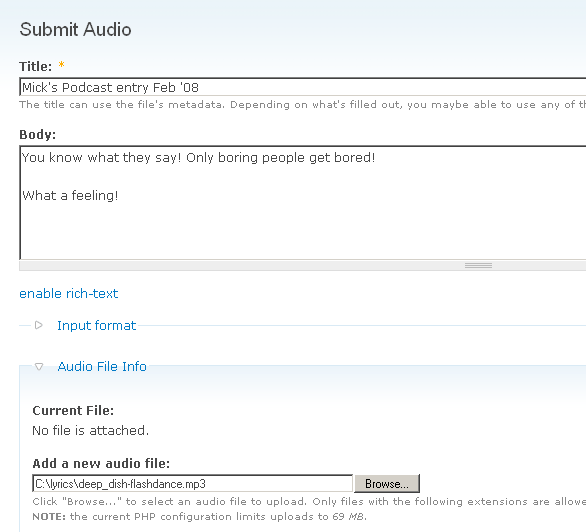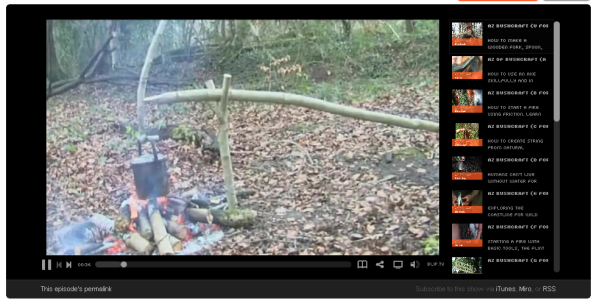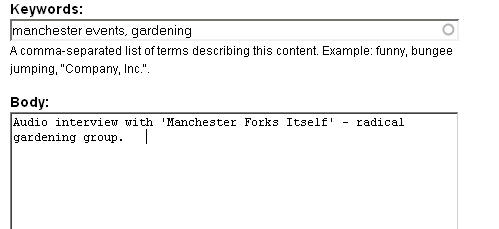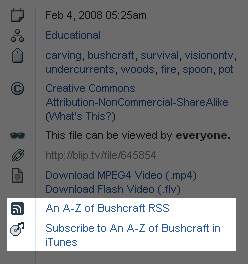Choosing a podcasting system
A podcasting distribution system will allow you to easily update your podcast feed every time you publish a new episode, this ensures people who subscribe to your podcast will automatically download the latest episode when they launch their Podcast playing software (iTunes or Songbird). Such a system is normally called a Content Management System (CMS).
How a podcasting distribution system works
To create a podcast you can either sign up to a web-based service or install software on your own server. When the software is installed it takes the form of a website which may look something like this when you choose to upload a file for your podcast.

When you have submitted a form like the one above, normally a podcasting CMS will do two things. Firstly it will create a page where your audio file can be downloaded and visitors to the website can see details about it, for example the title, description etc. Secondly it will add the details of the file to the RSS feed that the website creates.
Different systems will present your podcast in different ways. The system we are using for this example is Drupal which presents a standard RSS icon at the bottom of the main page.

This icon which links to the RSS file allows you to subscribe to the podcast feed. If you take a closer look at the RSS file you should see the details of your recent addition.

So those are the essentials of what you want from a Podcasting system;
- Some way of uploading or linking to your audio file
- Away of presenting the audio file and data via webpages
- The RSS feed
There are many different systems for creating podcasts. Let's look at some of them with regards to other features that you might want for your podcast creating software.
Using a service or setting up your own system
When talking about a service for podcasting, this means that you sign up to a website that allows you to create your own podcast. There are many around. Some are commercial and use adverts placed around your content to generate revenue. Others services are non-profit and apply to foundations and trusts to finance the cost of running the service. Some are even just run by volunteers.
When we mention 'setting up your own system' for podcasts. This means installing some software on an internet server which you have access to.
There are advantages and disadvantages to either method. The answer to which you choose will probably depends a lot on the resources you have at your disposal and how particular about how your web presence is going to look.
Using a service
The good news is that you can get most of the benefits and features of podcasting by using free services; the only disadvantage being that you are not able to customise the look of the service to suit what you need.
If it's essential that you host your files in a totally non-commercial setting then most solutions use the Internet Archive (archive.org) as a free hosting service. After all it won't look good if you create a video condemning a commercial product or corporation and then have your video hosted on a page which contains an advertisement by the corporation you are criticising.
In this way archive.org is a good solution as it doesn't feature advertisements. However it doesn't create personal Podcasts or give you a home page to customise. You will have to use another system like Ourmedia in combination with the free hosting of the Internet Archive to achieve those aims.
Some free services - advantages and disadvantages
Ourmedia.org offers you a homepage with your own featured audio / video file. However because they use external hosting with archive.org, it can be a bit tricky to get started, especially if you need to upload large files. You need to sign up for accounts with three services to get started which can make it really challenging.
Wordpress.com also offers a free service but it has the same issue unless you pay a relatively small fee to upgrade to a Pro account, which allows you to upload large files. There are ways to get around the lack of file uploading for the basic account. You can embed video that you have uploaded elsewhere, to services like Blip.tv, for example.
The easiest way to create your own Podcast page is to use a commercial service like Blip.tv (audio and video) or Daily Motion (video). While you can't totally customise the look of your home page on these sites, there are a lot of really nice features available besides automatic podcast creation.
One such feature from Blip.tv is a player which you can customise and host on other websites. It has a list of your files which it can play and a link to your feed in different formats. This is shown below.

Setting up your own system
But of course if you do have access to a webserver that you can play about with and the services of a good internet techie, then you can create a much more customised, and 'richer' web presense for your Podcast. Setting up your own system will allow you to take advantage of most of the podcasting features mentioned on this page.
Normally these systems will require access to a MySql database or similar, ftp access to an internet server running Apache or similar and php. There is a certain level of technical knowledge that is required to set up such a system. It's worth doing some research before starting on this path.
Uploading 'large' files
Web forms generally provide an easy way to upload files to your website. However files over 25-30mb can start to be tricky to upload with web forms if you don't have a fast internet connection.

In this example, while the server limit is set to 69MB, your local connection might not be stable enough for that to work. To counter this problem, Podcasting systems often have alternate ways of uploading large files.
You will therefore need to use other methods to upload your files such as a publishing tool or an FTP package (File Transfer Protocol).
A publisher tool
Publishing tools that you download and run on your computer allow you to upload your file to the internet along with the details. Some examples are archive.org's CC publisher, Blip.tv's UpperBlip or Ourmedia's spinXpress. This is very useful for 'large' files as the connection created by these tools is much more stable that that of web forms.
Ability to link to files
Say you already host your audio files somewhere else, maybe a service like archive.org or someone has kindly offered to do that. If this is the case then it makes sense that you will want to 'link' to your online audio rather than having to upload them via web-forms. if this is something you need to do you'll probably want to use a more advanced system like Wordpress or Drupal.
Categorising your Podcast entries to create different feeds
It may be useful to you to create different Podcasts using the same Podcasting system. For example you might want to have a Podcast feed on Manchester events, and one on Gardening. However you may want to create a Podcast entry on a gardening event in Manchester. If you have a system that allows you to create different categories for each entry then you only have to upload your file and details once and mark it with the appropriate categories to make it entry to appear in both Podcast feeds.
This can be done in various ways with different Podcasting systems. It would take too long to explain the full details of each system. But here is one way of doing it in Drupal.

Compatibility with Video podcasting
If you are an audio podcaster, you may not feel that this is a problem. However there are some systems that allow you to create Video podcasts as well as Audio podcasts using the same technology. Even if you or your group aren't using video now, if you can imagine a situation where you may wish to in the future, it's probably worth making sure you choose a system that can handle video files.
Compatibility of your Podcast with 'Podcatchers'
After going to all the effort of creating your podcast you want to make sure that it is compatible with as many Podcast players (Podcatchers) as possible. iTunes, Juice and Songbird being some of the most prominent.

For example the image above from a page on Blip.tv shows links to 2 different kinds of Podcast feeds. One is a standard Media RSS feed and the other is a slightly different one for iTunes so that it can appear in the correct category.





